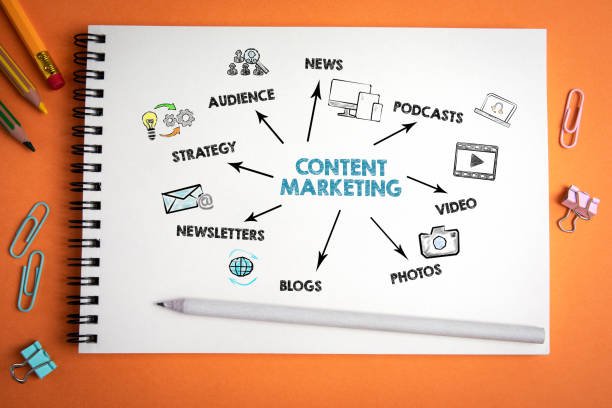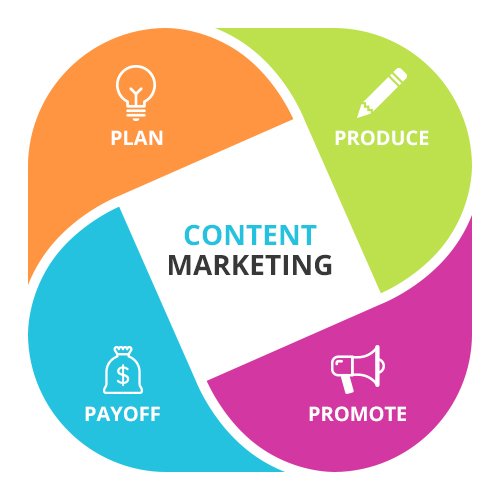Content Marketing is a powerful device in emblem strategy because it enables organizations to construct consciousness, engage audiences, and set up authority in their enterprise. while incorporated correctly into a brand strategy, content material advertising can power customer loyalty, help enterprise dreams, and differentiate the logo from the competition. right here’s how content marketing suits right into a broader brand method:
1. Constructing Emblem Cognizance
– Cause: content material advertising introduces the logo to new audiences and increases visibility.
– Strategies:
– Publish blog posts, films, infographics, and social media content material that align with the brand’s voice and values.
– Use search engine optimization (SEO) to make sure content ranks properly on search engines like google and yahoo.
– Leverage storytelling to make the brand memorable and relatable.
– Impact: Constant, content allows the brand to attain a much wider target audience and live pinnacle-of-mind.
2. Establishing Brand Authority
– Cause: content advertising and marketing positions the emblem as an idea chief and relies on useful resources in its enterprise.
– Strategies:
– Create in-depth publications, whitepapers, and case studies that exhibit expertise.
– proportion insights, traits, and data–driven content to illustrate enterprise knowledge.
– Host webinars, and podcasts, or stay Q&A classes to engage without delay with the audience.
– Impact: Authority builds agreement, that may result in extended purchaser loyalty and conversions.
3. Engaging and Instructing the Target Audience
– Reason: Content material advertising and marketing affords value to the target market using addressing their needs, ache points, and pastimes.
– Strategies:
– Broaden instructional content material like tutorials, how-to publications, and FAQs.
– Use interactive content which includes quizzes, polls, and calculators to interact with customers.
– Share patron achievement stories and testimonials to construct credibility.
– Effect: Attractive content fosters a deeper connection with the target audience and encourages them to interact with the emblem.
4. Helping the Client’s Journey
– Reason: Content Advertising nurtures potential clients at every degree of the consumer’s journey (cognizance, consideration, selection).
– Techniques:
– Attention Level: Create weblog posts, social media content, and motion pictures that cope with wide subjects and entice new audiences.
– Attention Level: offer contrast publications, product demos, and professional opinions to assist customers compare alternatives.
– Selection Degree: provide case studies, testimonials, and unfastened trials to persuade users to pick your brand.
– Impact: Tailor-made content material ensures the emblem remains relevant and beneficial for the duration of the consumer journey.
5. Reinforcing Brand Identification
– Reason: content marketing communicates the logo’s values, project, and character.
– Strategies:
– Use constant messaging, tone, and visuals throughout all content material.
– Percentage in the back-of-the-scenes tales or worker spotlights to humanize the logo.
– Align content with the logo’s core values (e.g., sustainability, innovation, inclusivity).
– Effect: Constant branding strengthens recognition and emotional connections with the audience.
6. Using Conversions and Income
– Motive: content material marketing can without delay affect purchasing decisions and force revenue.
– Techniques:
– Create product-centered content like tutorials, unboxing movies, and user courses.
– Use email advertising campaigns to share personalized offers and guidelines.
– Encompass clean calls-to-motion (CTAs) in content material to guide customers toward the next step.
– Effect: Strategic content material can flip prospects into clients and inspire repeat purchases.
7. Constructing Community and Loyalty
– Purpose: content advertising and marketing fosters an experience of community and keeps existing customers engaged.
– Techniques:
– Encourage person-generated content material (e.g., reviews, social media posts) to construct a network across the logo.
– Share distinctive content material or early access to products for loyal clients.
– Create content that celebrates milestones, activities, or customer achievements.
– Effect: A sturdy community increases patron retention and advocacy.
8. Measuring and Optimizing Performance
– Purpose: Tracking content’s overall performance ensures the strategy aligns with emblem dreams.
– Strategies:
– Use analytics equipment to degree metrics like engagement, visitors, and conversions.
– Conduct A/B trying to optimize headlines, visuals, and CTAs.
– Acquire target market feedback to refine content topics and formats.
– Effect: statistics–driven choices enhance the effectiveness of content material advertising efforts.
Examples of content marketing in logo approach
– Pink Bull: makes use of excessive–electricity movies, occasion sponsorships, and athlete memories to align with its adventurous, excessive–overall performance emblem photo.
– Hub Spot: Gives loose academic sources (blogs, templates, publications) to position itself as a pacesetter in advertising and sales software programs.
– Coca-Cola: Specializes in storytelling and emotional connections via campaigns like “Share a Coke.”
Key Takeaways
– Content material marketing is a strategic device for constructing logo consciousness, authority, and loyalty.
– It ought to align with the brand’s identity, values, and target market alternatives.
– By offering cost at every level of the patron adventure, content material advertising and marketing drive engagement, conversions, and long–term growth.
When performed nicely, content material advertising turns into a quintessential part of a logo’s method, helping it stand out in a crowded marketplace and construct meaningful relationships with its target audience.
Content Marketing for Spark Media Innovation
Content Marketing in Brand Strategy specifically for “Spark Media Innovation”. Based on the name,
I’ll assume your company is focused on innovation, creativity, and cutting-edge
solutions in the media or technology space. Here’s how content marketing can align
with your brand strategy:
1. Building Brand Awareness for Spark Media
Innovation
– Purpose: Establish Spark Media Innovation is a forward-thinking leader in the media and technology
industry.
– Strategies:
– Create thought-provoking content like blogs, videos, and infographics about emerging media trends (e.g., AI in media, immersive storytelling, or data-driven content strategies).
– Leverage social media platforms to share bite-sized, innovative ideas and insights.
– Use SEO to target keywords like “media innovation trends” or “future of digital media.”
– Impact: Position Spark Media Innovation is a go-to resource for cutting-edge media insights.
2. Establishing Authority in Media Innovation
– Purpose: Showcase Spark Media Innovation’s expertise and thought leadership.
– Strategies:
– Publish whitepapers or case studies on successful media innovation projects.
– Host webinars or podcasts featuring industry experts discussing the future of media.
– Share data-driven insights and research reports on topics like audience engagement, content personalization, or media technology advancements.
– Impact: Build trust and credibility, making Spark Media Innovation a trusted name in the industry.
3. Engaging and Educating Your Audience
– Purpose: Provide value to your audience by addressing their challenges and interests in media
innovation.
– Strategies:
– Create educational content like tutorials on using innovative media tools or platforms.
– Develop interactive content such as quizzes (“What’s Your Media Innovation Style?”) or calculators (e.g., ROI of media innovation).
– Share success stories of how Spark Media Innovation has helped clients achieve their goals.
– Impact: Foster deeper connections with your audience by solving their problems and inspiring
them with innovative ideas.
4. Supporting the Customer Journey
– Purpose: Guide
potential clients through the buyer’s journey with tailored content.
– Strategies:
– Awareness Stage: Publish blogs or videos on
Topics like “Top Media Trends for 2024” or “How Media Innovation Drives ROI.”
– Consideration Stage: Offer comparison guides (e.g., “Traditional Media vs. Innovative Media Solutions”) or product demos.
– Decision Stage: Share case studies,
testimonials, or free consultations to showcase Spark Media Innovation’s
results.
– Impact: Nurture leads and convert them into loyal clients.
5. Reinforcing Spark Media Innovation’s Brand Identity
– Purpose: Communicate your brand’s innovative, creative, and forward-thinking personality.
– Strategies:
– Use a consistent tone and visual style across all content (e.g., bold, modern, and tech-savvy).
– Share behind-the-scenes content showcasing your team’s creative process or innovative projects.
– Highlight your core values (e.g., innovation, collaboration, and excellence) in your messaging.
– Impact: Strengthen brand recognition and emotional connections with your audience.
6. Driving Conversions and Sales
– Purpose: Use content to directly influence purchasing decisions and grow revenue.
– Strategies:
– Create product-focused content like explainer videos or client success stories.
– Use email marketing to share personalized offers, industry insights, or exclusive updates.
– Include clear CTAs in your content (e.g., “Schedule a Demo” or “Download Our Media Innovation Guide”).
– Impact: Turn prospects into clients and encourage repeat business.
7. Building a Community Around Innovation
– Purpose: Foster a sense of community and loyalty among your audience.
– Strategies:
– Encourage user-generated content by asking clients to share their experiences with Spark Media Innovation.
– Create a LinkedIn group or online forum for media professionals to discuss
innovation trends.
– Share exclusive content or early access to new tools for loyal clients.
– Impact: Build a loyal community that advocates for your brand.
8. Measuring and Optimizing Performance
– Purpose: Ensure your content marketing efforts align with Spark Media Innovation’s goals.
– Strategies:
– Use analytics tools to track metrics like website traffic, engagement, and lead generation.
– Conduct A/B testing to optimize headlines, visuals, and CTAs.
– Gather feedback from clients and prospects to refine your content strategy.
– Impact: Continuously improve your content to maximize ROI.
Content Ideas for Spark Media Innovation
1. Blog Posts:
– “5 Media Innovation Trends Shaping 2024”
– “How AI is Revolutionizing Content Creation”
– “The Role of Data in Personalized Media Experiences”
2. Videos:
– Explainer videos on your innovative media solutions.
– Client testimonials showcasing successful projects.
– Behind-the-scenes looks at your creative process.
3. Interactive Content:
– Quizzes: “What’s Your Media Innovation Style?”
– Calculators: “ROI of Media Innovation for Your Business.”
4. Social Media Campaigns:
– #InnovateWithSpark: Share stories of innovation in media.
– Weekly tips on leveraging media technology.
5. Webinars/Podcasts:
– “The Future of Media: Trends and Opportunities”
– Interviews with industry leaders on
innovation.
Key Takeaways for Spark Media Innovation
– Content marketing is a strategic tool to position your brand as a leader in media innovation.
– Focus on creating value-driven, innovative content that aligns with your brand’s identity and audience needs.
– Use content to build awareness, establish authority, and drive conversions while fostering a loyal community.


